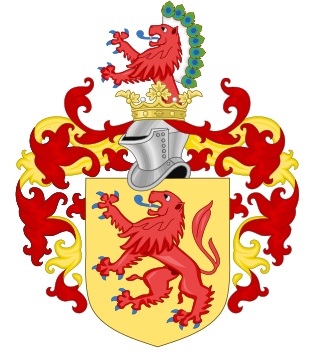
The House of Habsburg, also known as the House of Austria, was one of the most prominent and important dynasties in European history.
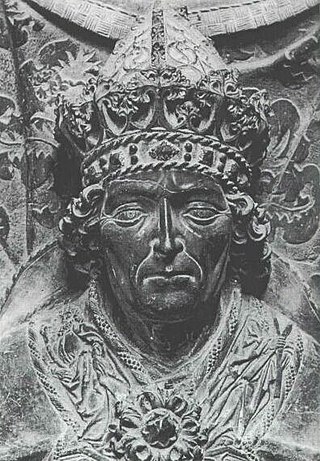
Louis IV, called the Bavarian, was King of the Romans from 1314, King of Italy from 1327, and Holy Roman Emperor from 1328 until his death in 1347.

The House of Babenberg was a noble dynasty of Austrian Dukes and Margraves. Originally from Bamberg in the Duchy of Franconia, the Babenbergs ruled the imperial Margraviate of Austria from its creation in 976 AD until its elevation to a duchy in 1156, and from then until the extinction of the line in 1246, whereafter they were succeeded by the House of Habsburg.

Ferdinand II was Holy Roman Emperor, King of Bohemia, Hungary, and Croatia from 1619 until his death in 1637. He was the son of Archduke Charles II of Inner Austria and Maria of Bavaria, who were devout Catholics. In 1590, when Ferdinand was 11 years old, they sent him to study at the Jesuits' college in Ingolstadt because they wanted to isolate him from the Lutheran nobles. A few months later, his father died, and he inherited Inner Austria–Styria, Carinthia, Carniola and smaller provinces. His cousin, Rudolf II, Holy Roman Emperor, who was the head of the Habsburg family, appointed regents to administer these lands.

The Counts of Celje or the Counts of Cilli were the most influential late medieval noble dynasty on the territory of present-day Slovenia. Risen as vassals of the Habsburg dukes of Styria in the early 14th century, they ruled the County of Cilli as immediate counts (Reichsgrafen) from 1341. They soon acquired a large number of feudal possessions also in today's Croatia and Bosnia. They rose to Princes of the Holy Roman Empire in 1436. The dynasty reached its peak with Ulrich II of Cilli, but with his death in 1456 they also died out, and after a war of succession, the Habsburgs inherited their domains.

Margaret of Austria, a member of the House of Babenberg, was German queen from 1225 until 1235, by her first marriage with King Henry (VII), and Queen of Bohemia from 1253 to 1260, by her second marriage with King Ottokar II.
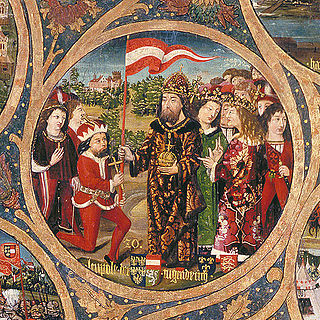
Leopold V, known as the Virtuous was a member of the House of Babenberg who reigned as Duke of Austria from 1177 and Duke of Styria within the Holy Roman Empire from 1192 until his death. The Georgenberg Pact resulted in Leopold being enfeoffed with Styria by Roman-German Emperor Frederick Barbarossa in 1193, which would lead to the eventual creation of modern Austria. Leopold was also known for his involvement in the Third Crusade where he fought in the Siege of Acre in 1191 and of his imprisonment of King Richard I in 1193 at Dürnstein Castle.
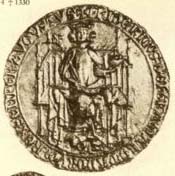
Frederick the Fair or the Handsome, from the House of Habsburg, was the duke of Austria and Styria from 1308 as well as the anti-king of Germany from 1314 until 1325 and then co-king until his death.

Albert II, known as the Wise or the Lame, a member of the House of Habsburg, was duke of Austria and Styria from 1330, as well as duke of Carinthia and margrave of Carniola from 1335 until his death.
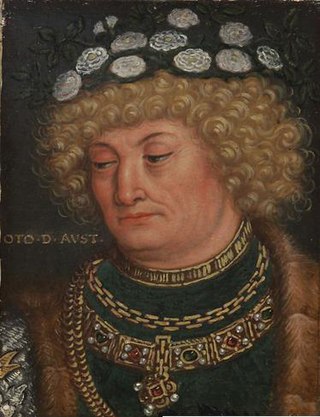
Otto, known as the Merry, was Duke of Austria and Styria from 1330, as well as Duke of Carinthia from 1335 until his death. A member of the House of Habsburg, he ruled jointly with his elder brother Duke Albert II.
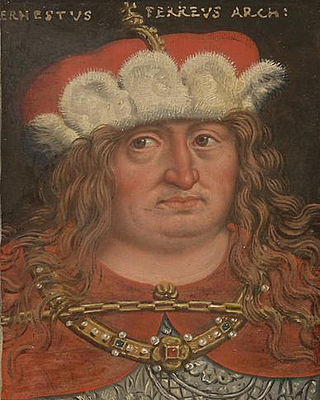
Ernest the Iron, a member of the House of Habsburg, ruled over the Inner Austrian duchies of Styria, Carinthia and Carniola from 1406 until his death. He was head of the Habsburg Leopoldian line from 1411.

Leopold I, called The Glorious, was Duke of Austria and Styria – as co-ruler with his elder brother Frederick the Fair – from 1308 until his death. A member of the House of Habsburg, he was the third son of Albert I of Germany and Elisabeth of Gorizia-Tyrol, a scion of the Meinhardiner dynasty.
The Albertinian line was a line of the Habsburg dynasty, begun by Duke Albert III of Austria, who, after death of his elder brother Rudolf IV, divided the Habsburg hereditary lands with his brother Leopold III by the 1379 Treaty of Neuberg. The branch finally became extinct in the male line with the early death of Ladislaus the Posthumous in 1457.

The Leopoldian line was a sequence of descent in the Habsburg dynasty begun by Duke Leopold III of Austria, who, after the death of his elder brother Rudolf IV, divided the Habsburg hereditary lands with his brother Albert III according to the 1379 Treaty of Neuberg.

Rudolf I of Bavaria, called "the Stammerer", a member of the Wittelsbach dynasty, was Duke of Upper Bavaria and Count Palatine of the Rhine from 1294 until 1317.

The Battle of Mühldorf was fought near Mühldorf am Inn on September 28, 1322 between the Duchy of (Upper) Bavaria and Austria. The Bavarians were led by the German king Louis of Wittelsbach, while the Austrians were under the command of his cousin, the anti-king Frederick of Habsburg.

The Duchy of Austria was a medieval principality of the Holy Roman Empire, established in 1156 by the Privilegium Minus, when the Margraviate of Austria (Ostarrîchi) was detached from Bavaria and elevated to a duchy in its own right. After the ruling dukes of the House of Babenberg became extinct in male line, there was as much as three decades of rivalry on inheritance and rulership, until the German king Rudolf I took over the dominion as the first monarch of the Habsburg dynasty in 1276. Thereafter, Austria became the patrimony and ancestral homeland of the dynasty and the nucleus of the Habsburg monarchy. In 1453, the archducal title of the Austrian rulers, invented by Duke Rudolf IV in the forged Privilegium Maius of 1359, was officially acknowledged by the Habsburg emperor Frederick III.

The (Princely) County of Tyrol was an estate of the Holy Roman Empire established about 1140. After 1253, it was ruled by the House of Gorizia and from 1363 by the House of Habsburg. In 1804, the County of Tyrol, unified with the secularised prince-bishoprics of Trent and Brixen, became a crown land of the Austrian Empire. From 1867, it was a Cisleithanian crown land of Austria-Hungary.

The Duchy of Styria was a duchy located in modern-day southern Austria and northern Slovenia. It was a part of the Holy Roman Empire until its dissolution in 1806 and a Cisleithanian crown land of Austria-Hungary until its dissolution in 1918.

Henry VI, a member of the Hohenstaufen dynasty, was King of Germany from 1169 and Holy Roman Emperor from 1191 until his death. From 1194 he was also King of Sicily.


















